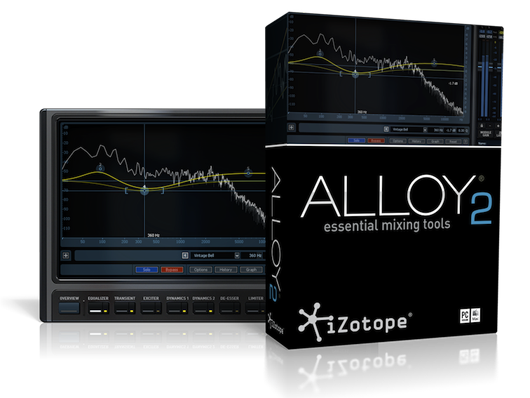Review: iZotope Alloy 2
iZotope‘s Alloy 2 plug-in is the software company’s second attempt to make a one-stop shop […]

iZotope‘s Alloy 2 plug-in is the software company’s second attempt to make a one-stop shop for single-channel processing (the original version of Alloy was released back in 2010). Combining a parametric equalizer, transient designer, harmonic exciter, two dynamics modules, a de-esser, and a limiter into one plug-in, Alloy 2 covers almost all signal processing needs in one convenient package that strikes an effective balance between ease of use and audio quality.
After installing Alloy 2 (a considerably painless process that requires no USB dongle or any such nonsense), the power of the plug-in is instantly usable via an array of global presets that serve as great starting points for sonic tweaking. Depending on the preset, different components are enabled, but most utilize the EQ, at least one dynamics processor, and either the transient designer or harmonic exciter to some degree. The presets are conveniently organized by instrument—bass, drums, guitar, keys, and even special effects and utility categories—and from there, each has detailed descriptions to start users on the right foot. Considering how many moving parts this plug-in utilizes, the global presets become immensely helpful with not only learning how best to fit all of the components together, but also figuring out how each one can be individually utilized to reap desired results.
Alloy’s user interface is crisp and clean, its simple design making it easy to navigate and understand. Virtually every desired control is present on the front panel of each separate module, and further levels of customization can be found by clicking on the ever-present “Options” button found towards the bottom of the window. Furthermore, each component can be bypassed individually allowing for scrutiny of A/B comparisons, while the graphic representations of the signal and levels supply detailed visual information about how the sound is behaving. And for those who like to dig even deeper, Alloy goes so far as to offer the ability to rearrange the order in which one’s signal passes through the various components with the “Graph” function. But perhaps the smartest aspect of Alloy’s usability lies in the “History” menu, which catalogs each change made in the plug-in and makes it possible to undo or go back to a previous state—even across different sessions and different instances of the plug-in. Basically, iZotope thought of just about everything.
But as with all audio gear, the most important aspect is—of course—sound quality, and to that effect, Alloy 2 delivers the same superb sound that iZotope has built its reputation on, most notably with the Ozone mastering suite. Although the combination of elements in Alloy 2 can lead you down many paths, the overall tonality lends itself to a clean, precise, and professional quality, rivaling industry standards such as the Waves bundles or Sony’s Oxford plug-ins. Still, it’s worth noting that Alloy 2 appears to be aimed at audio engineers more than bedroom producers, and while the transient designer and harmonic exciters (which give the option of blending between “Tube,” “Tape,” “Warm,” and “Retro”) can warp and complement sounds considerably, Alloy 2 is best when used to make elements fit into a mix—enhancing, repairing, or polishing the specifics of one’s audio spectrum. Alloy 2 isn’t going to give producers biting distortions or provide their tracks with colorful vocoders or glorious reverbs, it will—when wielded correctly—just make all those things sound better.
Considering the software’s more than reasonable price point and vast range of necessary uses, Alloy 2 largely asserts itself as an essential piece of software for any digital home studio intent on achieving pristine sound—whether it be generated from inside or outside the box.
MSRP: $199 ($149 before September 6)

